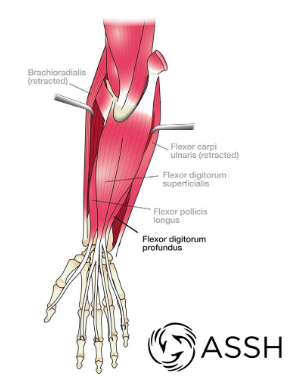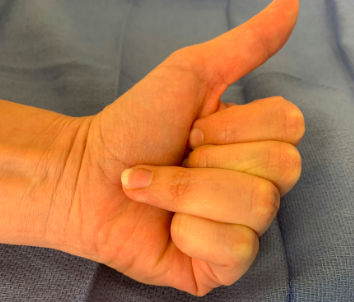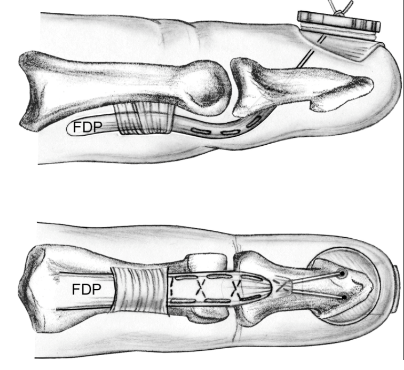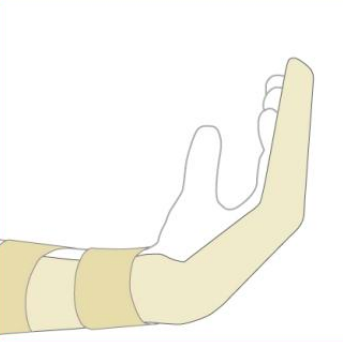Jersey Finger
A “jersey finger” refers to a disruption of the tendon that bends the fingertip down. It’s named this way because it can occur in athletes who have gripped the jersey of an opposing player who is trying to get away. This action can cause an abrupt extension in the finger on a clenched hand. That can be enough to pull the tendon, and sometimes part of the bone, away from its insertion at the tip of the finger. While this example is classic, other sports and activities (e.g. rock climbing) can lead to a jersey finger.
Most of the tendons that move your fingers originate in the forearm. The flexor digitorum profundus muscle (Figure 1), specifically, is the muscle origin of the tendons that bend the fingertips, and thus the medical term for a “jersey finger” is a flexor digitorum profundus (FDP) avulsion.
Jersey finger is traditionally classified as type I, II or III. Type I is the most severe (total retraction of tendon into the palm). Type III is the most favorable (little to no retraction of tendon).

Signs and Symptoms

With a jersey finger, the injured finger is unable to bend at the fingertip, even though the finger may be able to bend at the other joints (Figure 2). You may be able to use your other hand to assist in bending the fingertip. The fingertip may be swollen and painful, depending on how the injury occurred and how much time has passed since the injury.
People often report hearing or feeling a “popping” sensation at the time of injury. The ring finger is most often involved, but any finger can be affected.
Treatment
The diagnosis of jersey finger is often made based on history and physical examination alone. Your doctor may order x-rays to see if a piece of bone has chipped off with the disrupted tendon. Whether or not there is an associated bony fracture and how far the disrupted tendon has retracted can have important implications for treatment.
The majority of jersey fingers require surgery to reattach the disrupted tendon, fix the bony fracture (if necessary), and thus restore the ability to bend the fingertip.
Some people may prefer to avoid surgery, either due to underlying medical conditions, or an inability or unwillingness to comply with post-surgery requirements such as immobilization and/or occupational hand therapy, if needed. These situations should be discussed with your hand surgeon, since the inability to bend the fingertip will likely be permanent without surgery. A delay in treatment may require a more complex procedure.
What to Expect with Surgery

The timing of surgery after your injury depends on whether there is an associated bony fracture and how far the disrupted tendon has retracted. It is important to consult a hand surgeon as soon as possible after your injury because delayed assessment and treatment can lead to a more difficult recovery.
There are various surgical methods to reconstruct the disrupted tendon. Your surgeon will likely choose from one of a few methods to make the repair; these options may include the suture-button method (depicted in Figure 3) or methods utilizing bone anchors. If there is an associated fracture, it may need to be repaired with pins or screws. Your surgeon will help guide you in choosing the appropriate method of reconstruction based on your individual injury pattern.
After surgery, you will likely be put in a splint for a period of time, possibly like the splint depicted in Figure 4. This will vary depending on the severity of injury, type of repair, and rehabilitation preferences of your surgeon. All jersey finger surgery patients will be required to do home exercises carefully chosen by your surgeon. Some patients may require therapy from a certified hand therapist to prevent stiffness and restore range of motion.

